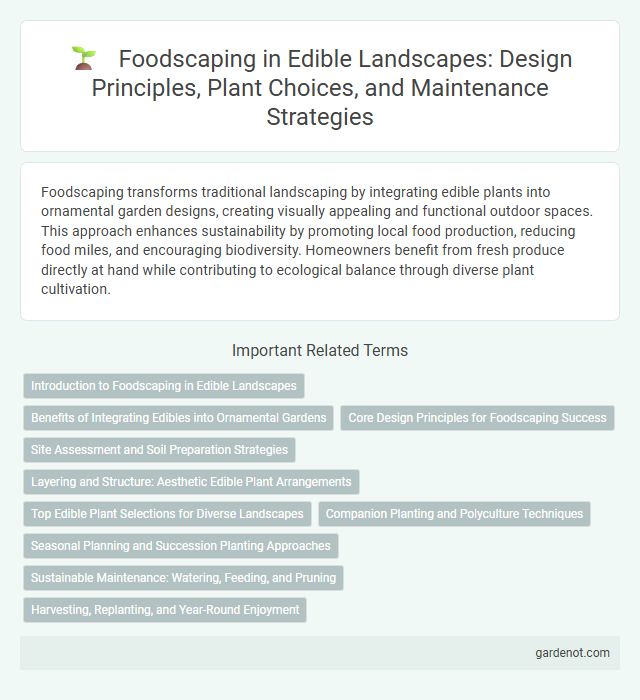Foodscaping transforms traditional landscaping by integrating edible plants into ornamental garden designs, creating visually appealing and functional outdoor spaces. This approach enhances sustainability by promoting local food production, reducing food miles, and encouraging biodiversity. Homeowners benefit from fresh produce directly at hand while contributing to ecological balance through diverse plant cultivation.
Introduction to Foodscaping in Edible Landscapes
Foodscaping integrates food-producing plants into traditional landscape design, transforming yards and green spaces into productive, sustainable environments. This practice emphasizes the strategic placement of fruits, vegetables, herbs, and edible flowers to enhance aesthetics while providing fresh, homegrown produce. Edible landscapes foster biodiversity, promote self-sufficiency, and support environmental health through natural pest control and soil enrichment methods.
Benefits of Integrating Edibles into Ornamental Gardens
Integrating edibles into ornamental gardens enhances biodiversity by attracting pollinators and beneficial insects that support plant health. Foodscaping reduces grocery costs and carbon footprints through local, fresh harvests directly from the garden. This sustainable practice improves soil quality and promotes natural pest control while enriching the garden's aesthetic and functional value.
Core Design Principles for Foodscaping Success
Foodscaping thrives on integrating edible plants with aesthetic landscape design, prioritizing plant diversity, seasonal harvest planning, and spatial efficiency. Emphasizing soil health, companion planting, and natural pest management enhances productivity and sustainability. Strategic layering of plant heights and textures ensures visual appeal alongside optimal sunlight exposure for crops.
Site Assessment and Soil Preparation Strategies
Site assessment for foodscaping involves analyzing soil composition, drainage patterns, sunlight exposure, and microclimates to optimize plant selection and placement. Soil preparation strategies include testing pH levels, incorporating organic matter like compost or aged manure, and ensuring proper aeration to promote nutrient availability and root development. Implementing techniques such as raised beds or mulching enhances soil structure and moisture retention, supporting a productive edible landscape.
Layering and Structure: Aesthetic Edible Plant Arrangements
Layering and structure within foodscaping create visually captivating edible landscapes by combining diverse plant heights, textures, and colors to maximize space and yield. Utilizing vertical and horizontal layers such as ground covers, mid-height herbs, and tall fruit trees enhances both aesthetic appeal and productivity. Strategic plant placement fosters natural pest control, improves soil health, and creates sustainable, functional garden ecosystems.
Top Edible Plant Selections for Diverse Landscapes
Foodscaping integrates productive edible plants into diverse landscapes, enhancing both beauty and utility. Top edible plant selections for varied environments include perennial herbs like rosemary and thyme, fruit-bearing shrubs such as blueberries, and nutrient-rich leafy greens like kale and Swiss chard. These resilient plants adapt to multiple climates and soil types, providing year-round harvests while promoting sustainable gardening practices.
Companion Planting and Polyculture Techniques
Foodscaping integrates companion planting and polyculture techniques to enhance edible landscapes by promoting biodiversity and natural pest control. Companion planting pairs compatible plants, like basil with tomatoes, to boost growth and deter pests, while polyculture involves cultivating multiple crop species together to improve soil health and maximize space efficiency. These strategies increase yield resilience and ecosystem sustainability within foodscaping designs.
Seasonal Planning and Succession Planting Approaches
Seasonal planning and succession planting are essential strategies in foodscaping to maximize yield and ensure a continuous harvest throughout the year. By selecting crops that thrive in specific seasons and staggering planting dates, gardeners can optimize space and nutrient use while reducing pest and disease pressure. Incorporating native and heirloom varieties also enhances biodiversity and resilience in edible landscapes.
Sustainable Maintenance: Watering, Feeding, and Pruning
Foodscaping incorporates sustainable maintenance practices such as efficient watering techniques, including drip irrigation and rainwater harvesting, to conserve water resources while promoting healthy plant growth. Organic feeding methods using compost and natural fertilizers enhance soil fertility and support long-term ecosystem balance. Regular pruning encourages productive harvests, prevents pest infestations, and maintains plant health without relying on chemical interventions.
Harvesting, Replanting, and Year-Round Enjoyment
Foodscaping integrates harvesting and replanting strategies to maintain productive edible landscapes throughout the year. Selecting perennial crops alongside seasonal vegetables ensures continuous yield and soil health, optimizing space and resources. Efficient crop rotation and timely harvesting maximize nutrient availability, promoting sustainable year-round enjoyment of fresh produce.
Foodscaping Infographic

 gardenot.com
gardenot.com